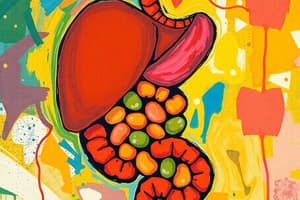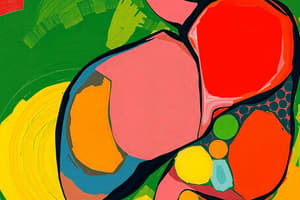Podcast
Questions and Answers
What primary condition leads to biliary obstruction within the first two months of life?
What primary condition leads to biliary obstruction within the first two months of life?
- Biliary Atresia (correct)
- Chronic Cholecystitis
- Acute Cholecystitis
- Cholelithiasis
Which of the following is most commonly associated with cholesterol stones in gallbladder?
Which of the following is most commonly associated with cholesterol stones in gallbladder?
- Emphasis on physical activity
- Excessive hydration
- Increased dietary fiber
- Decreased bile acids (correct)
What is a characteristic feature of chronic cholecystitis?
What is a characteristic feature of chronic cholecystitis?
- Immediate surgical intervention
- Formation of biliary stones exclusively
- Acute inflammation with bacterial overgrowth
- Herniation of gallbladder mucosa into the muscular wall (correct)
What symptom is commonly associated with biliary colic?
What symptom is commonly associated with biliary colic?
Which risk factor significantly increases the likelihood of developing gallstones?
Which risk factor significantly increases the likelihood of developing gallstones?
What is the most common complication associated with untreated acute cholecystitis?
What is the most common complication associated with untreated acute cholecystitis?
What is a late complication of chronic cholecystitis?
What is a late complication of chronic cholecystitis?
Which of the following enzymes is likely to be elevated in a patient with acute cholecystitis?
Which of the following enzymes is likely to be elevated in a patient with acute cholecystitis?
Flashcards
Biliary Atresia
Biliary Atresia
A condition where the bile ducts outside the liver fail to form or are destroyed early in life, causing blockage and leading to jaundice and cirrhosis.
Gallstones (Cholelithiasis)
Gallstones (Cholelithiasis)
Solid, round stones forming inside the gallbladder, often due to imbalances in cholesterol, bilirubin, or bile acids.
Biliary Colic
Biliary Colic
A sudden, intense pain in the upper right abdomen caused by a gallstone blocking the cystic duct, the tube leading out of the gallbladder.
Acute Cholecystitis
Acute Cholecystitis
Signup and view all the flashcards
Chronic Cholecystitis
Chronic Cholecystitis
Signup and view all the flashcards
Porcelain Gallbladder
Porcelain Gallbladder
Signup and view all the flashcards
Cholesterol Gallstones
Cholesterol Gallstones
Signup and view all the flashcards
Bilirubin Gallstones
Bilirubin Gallstones
Signup and view all the flashcards
Study Notes
Biliary Tract Disorders
- Biliary Atresia:
- Failure of the extrahepatic biliary tree to form or early destruction
- Leads to biliary obstruction within the first two months of life
- Presents with jaundice and cirrhosis
- Cholelithiasis (Gallstones):
- Solid, round stones formed in the gallbladder
- Primarily composed of cholesterol (90%) or bilirubin
- Factors contributing to stone formation:
- Supersaturation of cholesterol or bilirubin in bile
- Decreased phospholipids or bile acids
- Stasis (slow movement of bile)
- Cholesterol stones are typically yellow and radiolucent, while bilirubin stones are usually radiopaque
- Risk factors for cholesterol stones include age (40s), estrogen, obesity, multiple pregnancies, oral contraceptives, clofibrate, Native American ethnicity, Crohn's disease, and cirrhosis.
Other Biliary Tract Conditions
-
Biliary Colic:
- Waxing and waning right upper quadrant pain
- Due to gallbladder contractions against a lodged stone in the cystic duct
- Symptoms resolve if the stone passes
- Obstruction in the common bile duct can lead to acute pancreatitis or obstructive jaundice
-
Acute Cholecystitis:
- Inflammation of the gallbladder wall
- Caused by an impacted stone in the cystic duct, leading to pressure, ischemia, bacterial overgrowth, and inflammation
- Presents with right upper quadrant pain, often radiating to the right scapula
- Associated symptoms include fever, increased white blood cell count, nausea, vomiting, and elevated serum alkaline phosphatase
-
Chronic Cholecystitis:
- Chronic inflammation of the gallbladder wall
- Often caused by chemical irritation from gallstones
- Characterized by herniation of gallbladder mucosa into the muscular wall (Rokitansky-Aschoff sinus)
- Presents with vague right upper quadrant pain, especially after eating
- Porcelain gallbladder is a late complication involving shrunken, hard gallbladder due to chronic inflammation, fibrosis and dystrophic calcification
-
Ascending Cholangitis:
- Bacterial infection of the bile ducts
- Typically due to ascending infection from the intestines
- Characterized by sepsis (high fever, chills), jaundice and abdominal pain
- Increased association with choledocholithiasis (stones in the common bile duct)
-
Gallstone Ileus:
- Gallstone enters and obstructs the small bowel
- Resulting from cholecystitis with formation of a fistula between the gallbladder and small bowel
-
Gallbladder Carcinoma:
- Adenocarcinoma of the gallbladder wall
- Gallstones, especially porcelain gallbladder, are major risk factors
-
Increased risk: Gallbladder disorders are associated with an increased risk of carcinoma or cancer
-
Treatment: Cholecystectomy (removal of the gallbladder) is often the standard treatment for many gallbladder disorders, especially if porcelain gallbladder is present.
Studying That Suits You
Use AI to generate personalized quizzes and flashcards to suit your learning preferences.




